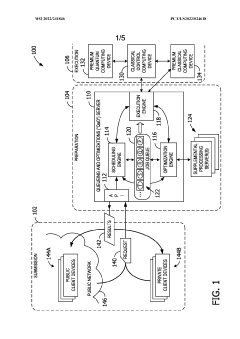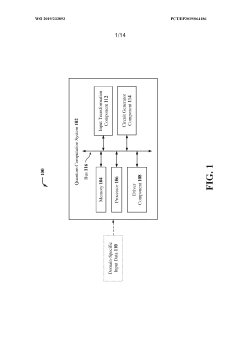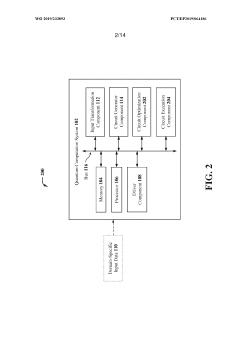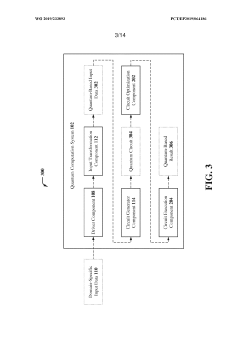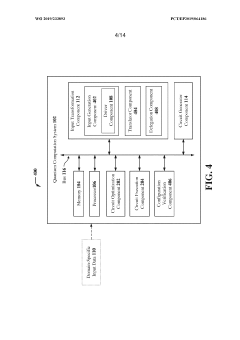Quantum Computing and its Potential in Archaeological Field Research
JUL 17, 202510 MIN READ
Generate Your Research Report Instantly with AI Agent
Patsnap Eureka helps you evaluate technical feasibility & market potential.
Quantum Computing in Archaeology: Background and Objectives
Quantum computing represents a revolutionary paradigm in computational technology, leveraging the principles of quantum mechanics to perform complex calculations at unprecedented speeds. In the context of archaeological field research, this emerging technology holds immense potential to transform traditional methodologies and unlock new avenues of discovery. The evolution of quantum computing can be traced back to the early 1980s when physicist Richard Feynman first proposed the concept of quantum simulation. Since then, significant advancements have been made in both theoretical foundations and practical implementations.
The primary objective of integrating quantum computing into archaeological research is to enhance data processing capabilities, enabling more sophisticated analysis of archaeological sites and artifacts. This integration aims to address longstanding challenges in the field, such as the interpretation of large-scale geospatial data, the reconstruction of fragmented artifacts, and the modeling of complex historical scenarios. By harnessing the power of quantum algorithms, archaeologists can potentially uncover hidden patterns and correlations within vast datasets that were previously inaccessible using classical computing methods.
The technological trajectory of quantum computing in archaeology is closely aligned with broader developments in quantum hardware and software. Key milestones include the development of quantum annealing devices, which have shown promise in optimization problems relevant to archaeological site mapping, and the advancement of quantum machine learning algorithms, which could revolutionize the classification and dating of artifacts. As quantum systems continue to scale up in terms of qubit count and coherence times, their applicability to archaeological challenges is expected to expand significantly.
Current trends in the field indicate a growing interest in quantum-enhanced imaging techniques, such as quantum radar and quantum sensing, which could dramatically improve the detection and characterization of buried archaeological features. Additionally, quantum-inspired algorithms are being explored for their potential to optimize survey strategies and resource allocation in field expeditions. The convergence of quantum computing with other cutting-edge technologies like artificial intelligence and remote sensing is expected to create synergistic effects, further amplifying the impact on archaeological research methodologies.
As we look towards the future, the integration of quantum computing in archaeology presents both exciting opportunities and significant challenges. The realization of these objectives will require interdisciplinary collaboration between quantum physicists, computer scientists, and archaeologists. Overcoming technical hurdles, such as error correction and scalability, will be crucial for the practical implementation of quantum solutions in field research. Nevertheless, the potential for quantum computing to unlock new dimensions of archaeological knowledge and understanding makes it a compelling area of exploration for the field.
The primary objective of integrating quantum computing into archaeological research is to enhance data processing capabilities, enabling more sophisticated analysis of archaeological sites and artifacts. This integration aims to address longstanding challenges in the field, such as the interpretation of large-scale geospatial data, the reconstruction of fragmented artifacts, and the modeling of complex historical scenarios. By harnessing the power of quantum algorithms, archaeologists can potentially uncover hidden patterns and correlations within vast datasets that were previously inaccessible using classical computing methods.
The technological trajectory of quantum computing in archaeology is closely aligned with broader developments in quantum hardware and software. Key milestones include the development of quantum annealing devices, which have shown promise in optimization problems relevant to archaeological site mapping, and the advancement of quantum machine learning algorithms, which could revolutionize the classification and dating of artifacts. As quantum systems continue to scale up in terms of qubit count and coherence times, their applicability to archaeological challenges is expected to expand significantly.
Current trends in the field indicate a growing interest in quantum-enhanced imaging techniques, such as quantum radar and quantum sensing, which could dramatically improve the detection and characterization of buried archaeological features. Additionally, quantum-inspired algorithms are being explored for their potential to optimize survey strategies and resource allocation in field expeditions. The convergence of quantum computing with other cutting-edge technologies like artificial intelligence and remote sensing is expected to create synergistic effects, further amplifying the impact on archaeological research methodologies.
As we look towards the future, the integration of quantum computing in archaeology presents both exciting opportunities and significant challenges. The realization of these objectives will require interdisciplinary collaboration between quantum physicists, computer scientists, and archaeologists. Overcoming technical hurdles, such as error correction and scalability, will be crucial for the practical implementation of quantum solutions in field research. Nevertheless, the potential for quantum computing to unlock new dimensions of archaeological knowledge and understanding makes it a compelling area of exploration for the field.
Market Analysis for Quantum-Enabled Archaeological Tools
The market for quantum-enabled archaeological tools is still in its nascent stages, but it shows promising potential for growth as quantum computing technology advances and becomes more accessible to research institutions and archaeological organizations. Currently, the market is primarily driven by academic and government-funded research projects, with a limited number of commercial applications.
The global archaeological equipment market, which includes traditional tools and emerging technologies, was valued at approximately $800 million in 2020 and is expected to grow at a CAGR of 6.5% from 2021 to 2028. While quantum-enabled tools represent only a small fraction of this market at present, they are poised to capture an increasing share as their capabilities and cost-effectiveness improve.
Key market segments for quantum-enabled archaeological tools include remote sensing and imaging, data analysis and pattern recognition, and simulation and modeling. Remote sensing applications, such as quantum-enhanced LiDAR and hyperspectral imaging, are expected to see the fastest adoption due to their potential to revolutionize site discovery and mapping. The data analysis segment is likely to grow as quantum algorithms demonstrate superior performance in processing complex archaeological datasets.
Geographically, North America and Europe are expected to dominate the market initially, given their advanced research infrastructure and higher investment in quantum technologies. However, emerging economies in Asia-Pacific and Latin America present significant growth opportunities as they seek to leverage cutting-edge technologies to preserve and study their rich archaeological heritage.
The primary end-users of quantum-enabled archaeological tools are expected to be universities, research institutions, government agencies, and museums. As the technology matures, there may be increased adoption by private archaeological firms and cultural resource management companies. The high initial cost of quantum computing infrastructure remains a significant barrier to widespread adoption, but cloud-based quantum services are emerging as a potential solution to democratize access.
Market growth drivers include increasing demand for non-invasive archaeological techniques, the need for more efficient data processing methods to handle large-scale archaeological datasets, and growing interest in applying advanced technologies to cultural heritage preservation. Additionally, government initiatives to support quantum research and its applications across various sectors are likely to indirectly benefit the archaeological tools market.
Challenges facing the market include the need for specialized training to operate quantum-enabled tools, concerns about data security and privacy when using cloud-based quantum services, and the current limitations of quantum hardware in terms of stability and error rates. Overcoming these challenges will be crucial for the widespread adoption of quantum-enabled archaeological tools and the realization of their full market potential.
The global archaeological equipment market, which includes traditional tools and emerging technologies, was valued at approximately $800 million in 2020 and is expected to grow at a CAGR of 6.5% from 2021 to 2028. While quantum-enabled tools represent only a small fraction of this market at present, they are poised to capture an increasing share as their capabilities and cost-effectiveness improve.
Key market segments for quantum-enabled archaeological tools include remote sensing and imaging, data analysis and pattern recognition, and simulation and modeling. Remote sensing applications, such as quantum-enhanced LiDAR and hyperspectral imaging, are expected to see the fastest adoption due to their potential to revolutionize site discovery and mapping. The data analysis segment is likely to grow as quantum algorithms demonstrate superior performance in processing complex archaeological datasets.
Geographically, North America and Europe are expected to dominate the market initially, given their advanced research infrastructure and higher investment in quantum technologies. However, emerging economies in Asia-Pacific and Latin America present significant growth opportunities as they seek to leverage cutting-edge technologies to preserve and study their rich archaeological heritage.
The primary end-users of quantum-enabled archaeological tools are expected to be universities, research institutions, government agencies, and museums. As the technology matures, there may be increased adoption by private archaeological firms and cultural resource management companies. The high initial cost of quantum computing infrastructure remains a significant barrier to widespread adoption, but cloud-based quantum services are emerging as a potential solution to democratize access.
Market growth drivers include increasing demand for non-invasive archaeological techniques, the need for more efficient data processing methods to handle large-scale archaeological datasets, and growing interest in applying advanced technologies to cultural heritage preservation. Additionally, government initiatives to support quantum research and its applications across various sectors are likely to indirectly benefit the archaeological tools market.
Challenges facing the market include the need for specialized training to operate quantum-enabled tools, concerns about data security and privacy when using cloud-based quantum services, and the current limitations of quantum hardware in terms of stability and error rates. Overcoming these challenges will be crucial for the widespread adoption of quantum-enabled archaeological tools and the realization of their full market potential.
Current Challenges in Quantum Computing for Archaeology
Quantum computing presents both exciting opportunities and significant challenges for archaeological field research. While the potential applications are vast, several key obstacles currently hinder the widespread adoption of quantum technologies in archaeology.
One of the primary challenges is the limited availability and accessibility of quantum computing systems. Most quantum computers are still in the experimental stage and are primarily housed in specialized research facilities. This restricts archaeologists' ability to directly utilize these systems for field research, making it difficult to integrate quantum computing into day-to-day archaeological practices.
The complexity of quantum algorithms and the need for specialized expertise pose another significant hurdle. Archaeologists typically lack the in-depth knowledge of quantum mechanics and programming required to develop and implement quantum algorithms effectively. This knowledge gap necessitates collaboration between archaeologists and quantum computing experts, which can be challenging to establish and maintain.
The current limitations of quantum hardware also present obstacles. Quantum computers are highly sensitive to environmental disturbances, requiring carefully controlled conditions to operate effectively. This makes it challenging to deploy quantum computing technologies in the often harsh and unpredictable conditions of archaeological field sites.
Data preparation and input for quantum systems remain complex processes. Archaeological data, often unstructured and diverse, needs to be converted into a format suitable for quantum processing. This conversion process can be time-consuming and may result in loss of nuanced information crucial for archaeological interpretation.
The issue of quantum error correction is another significant challenge. Current quantum systems are prone to errors due to decoherence and other quantum effects. While error correction techniques are advancing, they are not yet robust enough to ensure reliable results for complex archaeological computations, potentially leading to inaccurate or misleading findings.
Cost is a major factor limiting the adoption of quantum computing in archaeology. The development and maintenance of quantum systems require substantial financial resources, often beyond the budgets of most archaeological research projects. This economic barrier restricts access to quantum technologies for many researchers in the field.
Lastly, there is a lack of standardized methodologies and best practices for applying quantum computing to archaeological problems. The field is still in its infancy, and there are few established protocols for integrating quantum approaches with traditional archaeological methods. This lack of standardization makes it challenging to validate results and compare findings across different research projects.
One of the primary challenges is the limited availability and accessibility of quantum computing systems. Most quantum computers are still in the experimental stage and are primarily housed in specialized research facilities. This restricts archaeologists' ability to directly utilize these systems for field research, making it difficult to integrate quantum computing into day-to-day archaeological practices.
The complexity of quantum algorithms and the need for specialized expertise pose another significant hurdle. Archaeologists typically lack the in-depth knowledge of quantum mechanics and programming required to develop and implement quantum algorithms effectively. This knowledge gap necessitates collaboration between archaeologists and quantum computing experts, which can be challenging to establish and maintain.
The current limitations of quantum hardware also present obstacles. Quantum computers are highly sensitive to environmental disturbances, requiring carefully controlled conditions to operate effectively. This makes it challenging to deploy quantum computing technologies in the often harsh and unpredictable conditions of archaeological field sites.
Data preparation and input for quantum systems remain complex processes. Archaeological data, often unstructured and diverse, needs to be converted into a format suitable for quantum processing. This conversion process can be time-consuming and may result in loss of nuanced information crucial for archaeological interpretation.
The issue of quantum error correction is another significant challenge. Current quantum systems are prone to errors due to decoherence and other quantum effects. While error correction techniques are advancing, they are not yet robust enough to ensure reliable results for complex archaeological computations, potentially leading to inaccurate or misleading findings.
Cost is a major factor limiting the adoption of quantum computing in archaeology. The development and maintenance of quantum systems require substantial financial resources, often beyond the budgets of most archaeological research projects. This economic barrier restricts access to quantum technologies for many researchers in the field.
Lastly, there is a lack of standardized methodologies and best practices for applying quantum computing to archaeological problems. The field is still in its infancy, and there are few established protocols for integrating quantum approaches with traditional archaeological methods. This lack of standardization makes it challenging to validate results and compare findings across different research projects.
Existing Quantum Solutions for Archaeological Research
01 Quantum Circuit Design and Optimization
This area focuses on developing and optimizing quantum circuits for various applications. It involves creating efficient quantum gate sequences, reducing circuit depth, and improving overall performance of quantum algorithms. Techniques may include circuit compression, gate decomposition, and noise mitigation strategies to enhance the reliability of quantum computations.- Quantum Computing Architectures: Various architectures for quantum computing systems are being developed, including superconducting circuits, trapped ions, and photonic systems. These architectures aim to improve qubit coherence, scalability, and error correction capabilities, enabling more powerful and reliable quantum computations.
- Quantum Error Correction and Fault Tolerance: Techniques for quantum error correction and fault-tolerant quantum computing are crucial for mitigating the effects of decoherence and errors in quantum systems. These methods involve encoding quantum information across multiple physical qubits and implementing error detection and correction protocols.
- Quantum Algorithms and Applications: Development of quantum algorithms for various applications, including cryptography, optimization, machine learning, and simulation of quantum systems. These algorithms leverage quantum superposition and entanglement to potentially outperform classical algorithms for specific problems.
- Quantum-Classical Hybrid Systems: Integration of quantum and classical computing systems to create hybrid architectures that leverage the strengths of both paradigms. These systems aim to optimize resource allocation, improve quantum circuit compilation, and enhance overall computational performance for practical applications.
- Quantum Communication and Networking: Development of quantum communication protocols and networking technologies for secure data transmission and distributed quantum computing. This includes quantum key distribution, quantum repeaters, and quantum internet architectures to enable long-distance quantum information transfer.
02 Quantum Error Correction and Fault Tolerance
This field addresses the challenge of maintaining quantum information coherence in the presence of noise and errors. It involves developing error correction codes, fault-tolerant quantum gates, and protocols to protect quantum states from decoherence. Techniques may include surface codes, topological quantum computing, and logical qubit encoding to improve the reliability and scalability of quantum systems.Expand Specific Solutions03 Quantum-Classical Hybrid Algorithms
This area explores the integration of quantum and classical computing paradigms to solve complex problems. It involves developing algorithms that leverage the strengths of both quantum and classical processors, such as variational quantum algorithms and quantum-inspired classical algorithms. These hybrid approaches aim to achieve quantum advantage in near-term devices and address practical applications in optimization, machine learning, and chemistry.Expand Specific Solutions04 Quantum Hardware Architecture
This field focuses on the design and implementation of quantum computing hardware. It encompasses various qubit technologies, such as superconducting circuits, trapped ions, and topological qubits. Research in this area aims to improve qubit coherence times, gate fidelities, and scalability of quantum processors. It also includes the development of control systems, readout mechanisms, and cryogenic infrastructure for quantum computers.Expand Specific Solutions05 Quantum Software and Programming Frameworks
This area involves the development of software tools, programming languages, and frameworks for quantum computing. It includes creating high-level quantum programming languages, compilers, and simulators to facilitate the implementation of quantum algorithms. Research in this field also focuses on quantum software stack optimization, quantum circuit visualization tools, and quantum-classical integration frameworks to bridge the gap between quantum hardware and applications.Expand Specific Solutions
Key Players in Quantum Archaeology Research
The quantum computing landscape in archaeological field research is in its early stages, with significant potential for growth. The market size is relatively small but expanding as more institutions recognize the technology's value. Quantum computing's application in archaeology is still emerging, with varying levels of technological maturity across different companies. Key players like IBM, Google, and Intel are at the forefront, leveraging their quantum expertise to develop solutions applicable to archaeological research. Universities such as Delft University of Technology and The University of Chicago are also contributing to advancements in this niche. As the technology evolves, we can expect increased collaboration between quantum computing firms and archaeological institutions to drive innovation and practical applications in the field.
Intel Corp.
Technical Solution: Intel's approach to quantum computing for archaeology focuses on developing cryogenic control chips for quantum systems, which could enable more stable and scalable quantum computers suitable for field research. Their Horse Ridge II chip aims to simplify the control electronics required for quantum processors, potentially making quantum systems more portable for on-site archaeological use[6]. Intel is also working on quantum simulation algorithms that could be applied to modeling complex archaeological systems, such as ancient trade networks or population movements. Their neuromorphic computing research, while not strictly quantum, could complement quantum systems in processing sensory data from archaeological sites[7].
Strengths: Strong integration with classical computing infrastructure, potential for more accessible quantum hardware. Weaknesses: Less advanced in pure quantum processing compared to some competitors.
International Business Machines Corp.
Technical Solution: IBM's quantum computing approach for archaeological field research focuses on developing quantum algorithms for complex data analysis and simulation. Their Quantum System One, with up to 127 qubits[1], can process vast amounts of archaeological data, including geospatial information, artifact analysis, and site modeling. IBM's quantum machine learning algorithms can identify patterns in archaeological datasets that classical computers might miss, potentially revealing hidden historical connections. They are also working on quantum-enhanced imaging techniques that could revolutionize non-invasive site exploration, allowing archaeologists to "see" beneath the ground with unprecedented clarity[2].
Strengths: Industry-leading quantum hardware and software integration, extensive research partnerships. Weaknesses: High cost of implementation, requires specialized expertise to operate effectively in archaeological contexts.
Breakthrough Quantum Algorithms for Archaeological Data Analysis
System and method of in-queue optimizations for quantum cloud computing
PatentWO2022231846A1
Innovation
- A quantum computing system with a queueing and optimizations (QaO) server that performs in-queue optimizations, including prediction models for execution times and machine calibration, to improve the quality of quantum circuit execution, reduce wait times, and balance performance characteristics, utilizing both intra-job and inter-job optimizations to enhance fidelity and throughput.
Quantum computations of classical specifications
PatentWO2019233893A1
Innovation
- A system comprising a processor and memory that transforms domain-specific input data into quantum-based data, generates quantum circuits, and executes them without relying on remote quantum resources, allowing for various domain-specific classical computation software to be used as front-ends and enabling configuration validation.
Ethical Implications of Quantum Computing in Archaeology
The integration of quantum computing in archaeological research raises significant ethical considerations that must be carefully addressed. As this powerful technology enhances our ability to process and analyze vast amounts of archaeological data, it also introduces new challenges related to data privacy, cultural sensitivity, and the potential misuse of information.
One primary ethical concern is the protection of sensitive archaeological data. Quantum computing's ability to rapidly process and decrypt large datasets could potentially compromise the security of confidential information about archaeological sites, artifacts, and cultural heritage. This raises questions about who should have access to such powerful computational tools and how to ensure that this information is not exploited for illegal activities, such as looting or trafficking of cultural artifacts.
Furthermore, the application of quantum computing in archaeology may exacerbate existing power imbalances in the field. Institutions and countries with access to this advanced technology could gain a significant advantage in archaeological research, potentially marginalizing researchers and communities with limited resources. This disparity could lead to a concentration of knowledge and control over cultural heritage in the hands of a few, raising concerns about equitable access to scientific advancements and the preservation of diverse perspectives in archaeological interpretation.
The use of quantum computing in archaeological research also presents challenges related to the interpretation and representation of cultural heritage. As algorithms become more sophisticated, there is a risk of over-reliance on computational models, potentially overshadowing traditional methods and local knowledge. This could lead to a decontextualization of archaeological findings and a loss of nuanced understanding of past cultures.
Additionally, the rapid advancement of quantum computing in archaeology may outpace the development of ethical guidelines and regulatory frameworks. There is a pressing need for interdisciplinary collaboration to establish protocols for the responsible use of this technology in archaeological research, ensuring that it respects cultural sensitivities, promotes inclusivity, and adheres to principles of scientific integrity.
Lastly, the potential of quantum computing to reconstruct highly detailed models of past societies and individuals raises privacy concerns for descendant communities. The ability to extract and analyze genetic information or create detailed simulations of ancient populations could infringe upon the rights and dignity of living individuals and groups connected to these past cultures.
In conclusion, while quantum computing offers tremendous potential for advancing archaeological research, it is crucial to approach its implementation with a strong ethical framework. This framework should address issues of data protection, equitable access, cultural sensitivity, and the responsible use of technology in interpreting and preserving our shared human heritage.
One primary ethical concern is the protection of sensitive archaeological data. Quantum computing's ability to rapidly process and decrypt large datasets could potentially compromise the security of confidential information about archaeological sites, artifacts, and cultural heritage. This raises questions about who should have access to such powerful computational tools and how to ensure that this information is not exploited for illegal activities, such as looting or trafficking of cultural artifacts.
Furthermore, the application of quantum computing in archaeology may exacerbate existing power imbalances in the field. Institutions and countries with access to this advanced technology could gain a significant advantage in archaeological research, potentially marginalizing researchers and communities with limited resources. This disparity could lead to a concentration of knowledge and control over cultural heritage in the hands of a few, raising concerns about equitable access to scientific advancements and the preservation of diverse perspectives in archaeological interpretation.
The use of quantum computing in archaeological research also presents challenges related to the interpretation and representation of cultural heritage. As algorithms become more sophisticated, there is a risk of over-reliance on computational models, potentially overshadowing traditional methods and local knowledge. This could lead to a decontextualization of archaeological findings and a loss of nuanced understanding of past cultures.
Additionally, the rapid advancement of quantum computing in archaeology may outpace the development of ethical guidelines and regulatory frameworks. There is a pressing need for interdisciplinary collaboration to establish protocols for the responsible use of this technology in archaeological research, ensuring that it respects cultural sensitivities, promotes inclusivity, and adheres to principles of scientific integrity.
Lastly, the potential of quantum computing to reconstruct highly detailed models of past societies and individuals raises privacy concerns for descendant communities. The ability to extract and analyze genetic information or create detailed simulations of ancient populations could infringe upon the rights and dignity of living individuals and groups connected to these past cultures.
In conclusion, while quantum computing offers tremendous potential for advancing archaeological research, it is crucial to approach its implementation with a strong ethical framework. This framework should address issues of data protection, equitable access, cultural sensitivity, and the responsible use of technology in interpreting and preserving our shared human heritage.
Interdisciplinary Collaboration Opportunities
Quantum computing's potential in archaeological field research opens up exciting opportunities for interdisciplinary collaboration. The convergence of quantum technologies with archaeology can revolutionize data analysis, imaging techniques, and simulation capabilities, fostering partnerships between quantum physicists, computer scientists, and archaeologists.
One key area of collaboration is in the development of quantum sensors for non-invasive archaeological prospection. These advanced sensors could significantly enhance the detection and mapping of buried archaeological features, offering higher resolution and deeper penetration than current geophysical methods. This collaboration would involve quantum physicists, materials scientists, and archaeological geophysicists working together to design and optimize quantum sensing devices for field applications.
Quantum machine learning algorithms present another avenue for interdisciplinary cooperation. By leveraging quantum computing's ability to process complex datasets, archaeologists could collaborate with quantum information scientists and data analysts to develop more sophisticated pattern recognition and classification tools. These tools could be applied to various archaeological data types, including artifact analysis, site distribution patterns, and ancient text decipherment.
The field of quantum imaging offers potential for collaboration between quantum optics experts and archaeological conservators. Quantum-enhanced imaging techniques could provide unprecedented detail in the analysis of delicate artifacts, revealing hidden features and aiding in conservation efforts. This partnership would require expertise in quantum optics, materials science, and archaeological conservation.
Quantum simulation capabilities could foster collaboration between quantum physicists, climate scientists, and archaeologists specializing in paleoenvironmental reconstruction. By simulating complex environmental systems with quantum computers, researchers could gain new insights into past climates and their impact on ancient societies, enhancing our understanding of human-environment interactions throughout history.
Lastly, the development of quantum-resistant cryptography for securing archaeological data presents an opportunity for collaboration between cryptographers, quantum information theorists, and archaeological data managers. As quantum computing advances, ensuring the long-term security of sensitive archaeological information becomes crucial, necessitating expertise from multiple disciplines.
These interdisciplinary collaborations not only advance archaeological research but also drive innovation in quantum technologies, creating a mutually beneficial relationship between seemingly disparate fields. By fostering these partnerships, the archaeological community can harness the full potential of quantum computing to unlock new dimensions in our understanding of the past.
One key area of collaboration is in the development of quantum sensors for non-invasive archaeological prospection. These advanced sensors could significantly enhance the detection and mapping of buried archaeological features, offering higher resolution and deeper penetration than current geophysical methods. This collaboration would involve quantum physicists, materials scientists, and archaeological geophysicists working together to design and optimize quantum sensing devices for field applications.
Quantum machine learning algorithms present another avenue for interdisciplinary cooperation. By leveraging quantum computing's ability to process complex datasets, archaeologists could collaborate with quantum information scientists and data analysts to develop more sophisticated pattern recognition and classification tools. These tools could be applied to various archaeological data types, including artifact analysis, site distribution patterns, and ancient text decipherment.
The field of quantum imaging offers potential for collaboration between quantum optics experts and archaeological conservators. Quantum-enhanced imaging techniques could provide unprecedented detail in the analysis of delicate artifacts, revealing hidden features and aiding in conservation efforts. This partnership would require expertise in quantum optics, materials science, and archaeological conservation.
Quantum simulation capabilities could foster collaboration between quantum physicists, climate scientists, and archaeologists specializing in paleoenvironmental reconstruction. By simulating complex environmental systems with quantum computers, researchers could gain new insights into past climates and their impact on ancient societies, enhancing our understanding of human-environment interactions throughout history.
Lastly, the development of quantum-resistant cryptography for securing archaeological data presents an opportunity for collaboration between cryptographers, quantum information theorists, and archaeological data managers. As quantum computing advances, ensuring the long-term security of sensitive archaeological information becomes crucial, necessitating expertise from multiple disciplines.
These interdisciplinary collaborations not only advance archaeological research but also drive innovation in quantum technologies, creating a mutually beneficial relationship between seemingly disparate fields. By fostering these partnerships, the archaeological community can harness the full potential of quantum computing to unlock new dimensions in our understanding of the past.
Unlock deeper insights with Patsnap Eureka Quick Research — get a full tech report to explore trends and direct your research. Try now!
Generate Your Research Report Instantly with AI Agent
Supercharge your innovation with Patsnap Eureka AI Agent Platform!



